Essay on Global Citizenship, Business Purpose, AI, and Life's Value
VerifiedAdded on 2020/11/23
|8
|1548
|149
Essay
AI Summary
This document presents four essays covering a range of contemporary topics. The first essay explores the concept of global citizenship, emphasizing individual responsibility towards global issues and the importance of critical thinking and education in fostering active participation. The second essay delves into the purpose of business, outlining various objectives such as profit generation, value addition, and social responsibility, and how these goals evolve with the changing business environment. The third essay focuses on artificial intelligence (AI), discussing its capabilities, benefits, and potential drawbacks, including concerns about unemployment and over-reliance on machines. The final essay examines the value of life through the lens of abortion, assisted suicide, and the death penalty, presenting different perspectives and ethical considerations surrounding these sensitive issues.

4 Essays
Paraphrase This Document
Need a fresh take? Get an instant paraphrase of this document with our AI Paraphraser
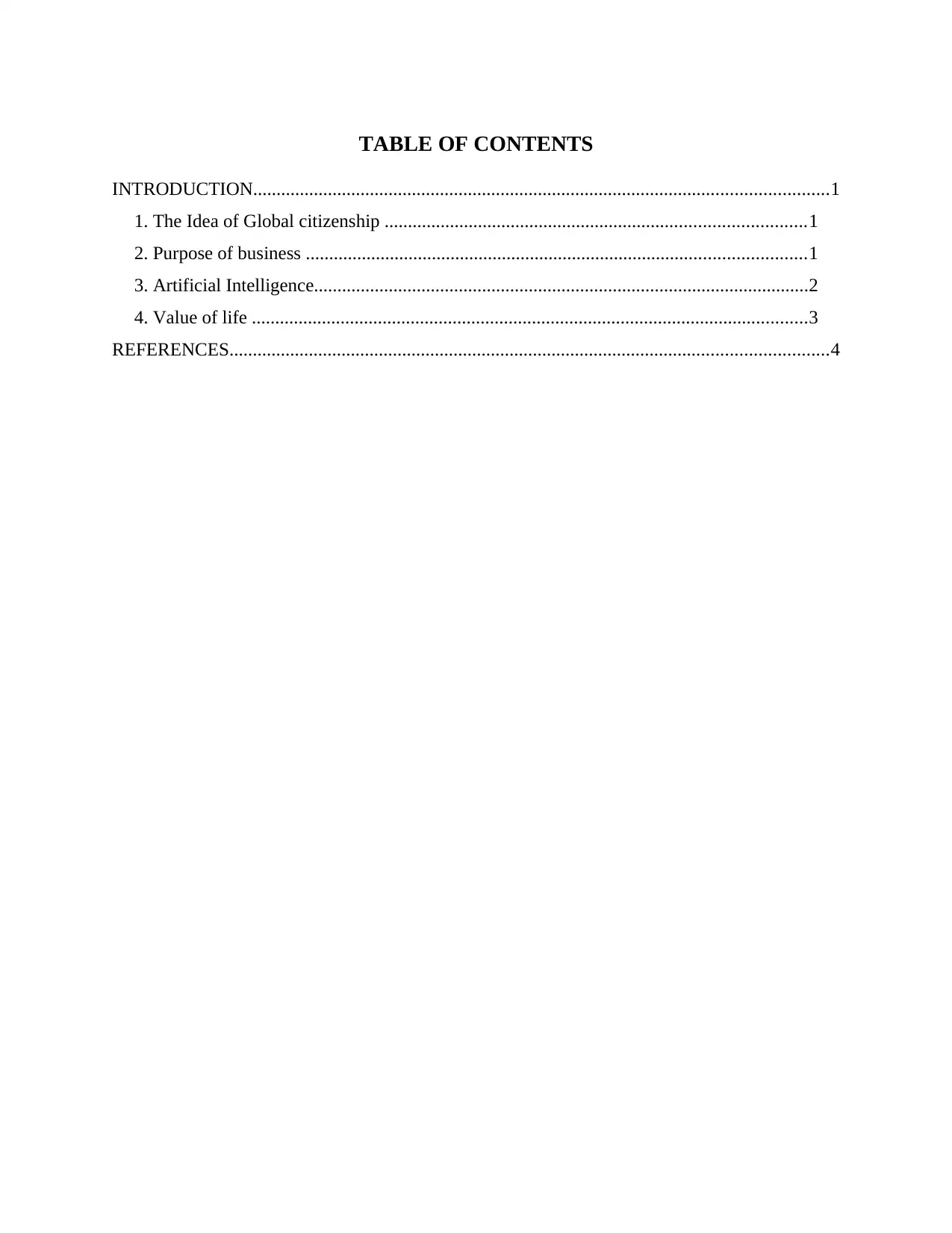
TABLE OF CONTENTS
INTRODUCTION...........................................................................................................................1
1. The Idea of Global citizenship ..........................................................................................1
2. Purpose of business ...........................................................................................................1
3. Artificial Intelligence..........................................................................................................2
4. Value of life .......................................................................................................................3
REFERENCES................................................................................................................................4
INTRODUCTION...........................................................................................................................1
1. The Idea of Global citizenship ..........................................................................................1
2. Purpose of business ...........................................................................................................1
3. Artificial Intelligence..........................................................................................................2
4. Value of life .......................................................................................................................3
REFERENCES................................................................................................................................4
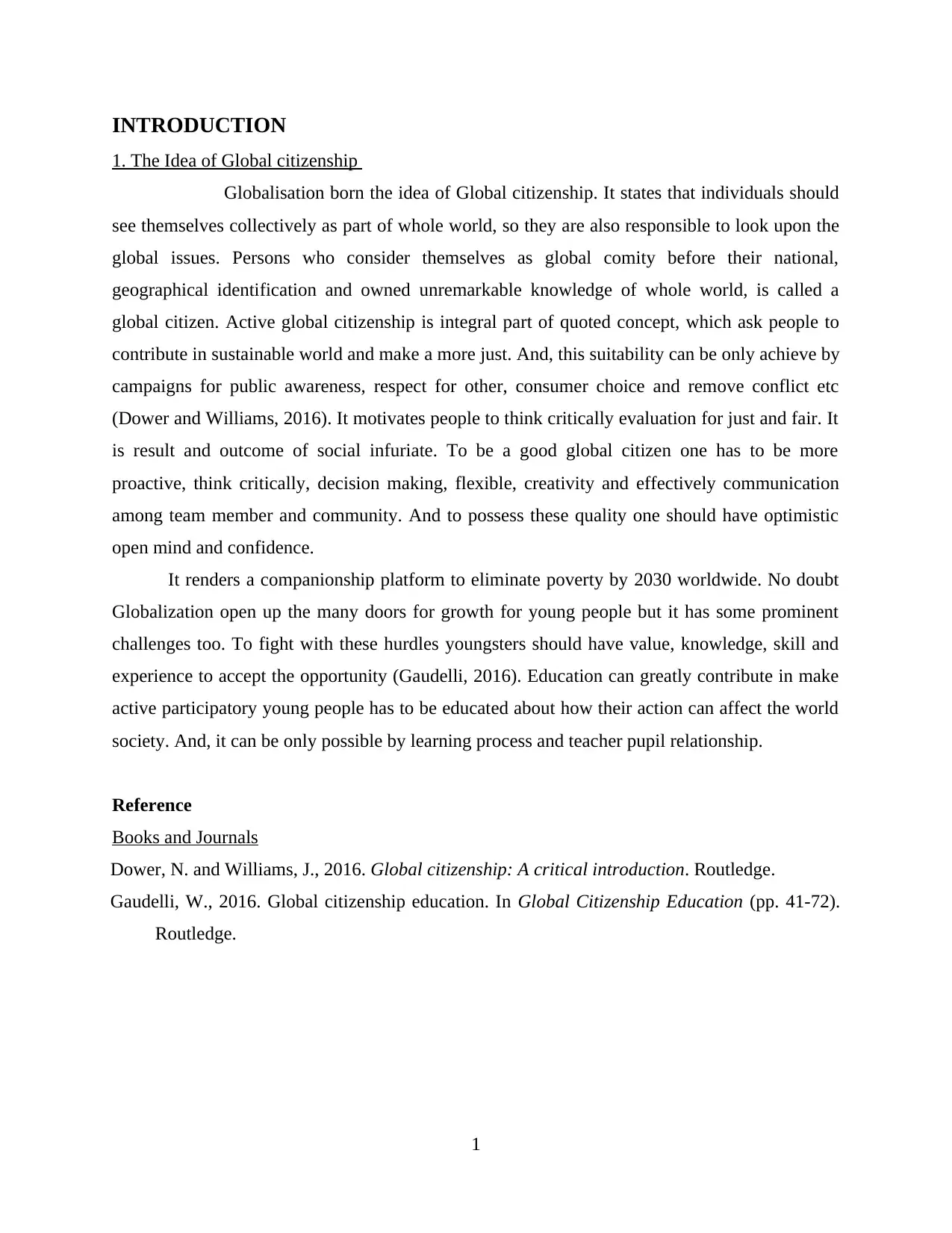
INTRODUCTION
1. The Idea of Global citizenship
Globalisation born the idea of Global citizenship. It states that individuals should
see themselves collectively as part of whole world, so they are also responsible to look upon the
global issues. Persons who consider themselves as global comity before their national,
geographical identification and owned unremarkable knowledge of whole world, is called a
global citizen. Active global citizenship is integral part of quoted concept, which ask people to
contribute in sustainable world and make a more just. And, this suitability can be only achieve by
campaigns for public awareness, respect for other, consumer choice and remove conflict etc
(Dower and Williams, 2016). It motivates people to think critically evaluation for just and fair. It
is result and outcome of social infuriate. To be a good global citizen one has to be more
proactive, think critically, decision making, flexible, creativity and effectively communication
among team member and community. And to possess these quality one should have optimistic
open mind and confidence.
It renders a companionship platform to eliminate poverty by 2030 worldwide. No doubt
Globalization open up the many doors for growth for young people but it has some prominent
challenges too. To fight with these hurdles youngsters should have value, knowledge, skill and
experience to accept the opportunity (Gaudelli, 2016). Education can greatly contribute in make
active participatory young people has to be educated about how their action can affect the world
society. And, it can be only possible by learning process and teacher pupil relationship.
Reference
Books and Journals
Dower, N. and Williams, J., 2016. Global citizenship: A critical introduction. Routledge.
Gaudelli, W., 2016. Global citizenship education. In Global Citizenship Education (pp. 41-72).
Routledge.
1
1. The Idea of Global citizenship
Globalisation born the idea of Global citizenship. It states that individuals should
see themselves collectively as part of whole world, so they are also responsible to look upon the
global issues. Persons who consider themselves as global comity before their national,
geographical identification and owned unremarkable knowledge of whole world, is called a
global citizen. Active global citizenship is integral part of quoted concept, which ask people to
contribute in sustainable world and make a more just. And, this suitability can be only achieve by
campaigns for public awareness, respect for other, consumer choice and remove conflict etc
(Dower and Williams, 2016). It motivates people to think critically evaluation for just and fair. It
is result and outcome of social infuriate. To be a good global citizen one has to be more
proactive, think critically, decision making, flexible, creativity and effectively communication
among team member and community. And to possess these quality one should have optimistic
open mind and confidence.
It renders a companionship platform to eliminate poverty by 2030 worldwide. No doubt
Globalization open up the many doors for growth for young people but it has some prominent
challenges too. To fight with these hurdles youngsters should have value, knowledge, skill and
experience to accept the opportunity (Gaudelli, 2016). Education can greatly contribute in make
active participatory young people has to be educated about how their action can affect the world
society. And, it can be only possible by learning process and teacher pupil relationship.
Reference
Books and Journals
Dower, N. and Williams, J., 2016. Global citizenship: A critical introduction. Routledge.
Gaudelli, W., 2016. Global citizenship education. In Global Citizenship Education (pp. 41-72).
Routledge.
1
⊘ This is a preview!⊘
Do you want full access?
Subscribe today to unlock all pages.

Trusted by 1+ million students worldwide
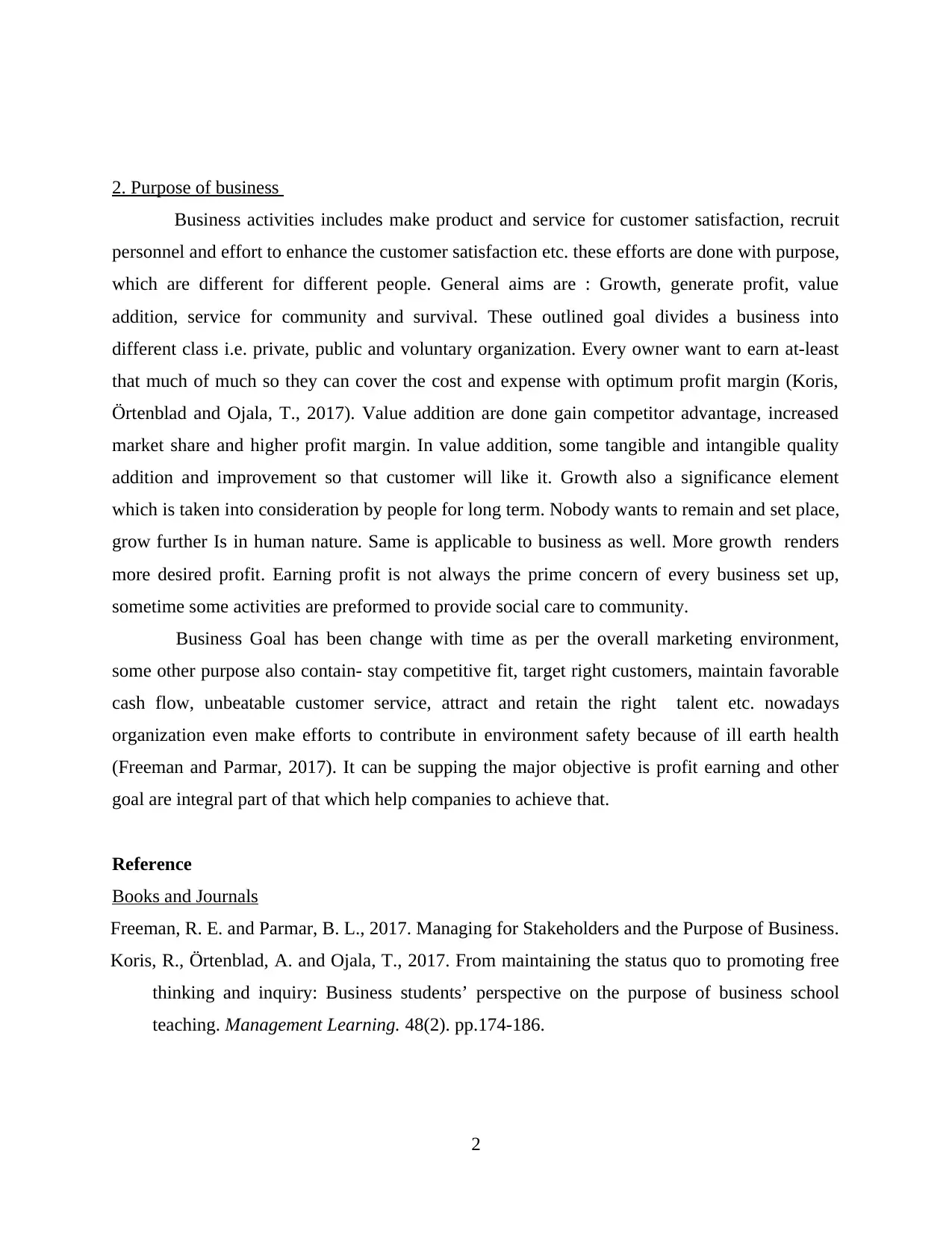
2. Purpose of business
Business activities includes make product and service for customer satisfaction, recruit
personnel and effort to enhance the customer satisfaction etc. these efforts are done with purpose,
which are different for different people. General aims are : Growth, generate profit, value
addition, service for community and survival. These outlined goal divides a business into
different class i.e. private, public and voluntary organization. Every owner want to earn at-least
that much of much so they can cover the cost and expense with optimum profit margin (Koris,
Örtenblad and Ojala, T., 2017). Value addition are done gain competitor advantage, increased
market share and higher profit margin. In value addition, some tangible and intangible quality
addition and improvement so that customer will like it. Growth also a significance element
which is taken into consideration by people for long term. Nobody wants to remain and set place,
grow further Is in human nature. Same is applicable to business as well. More growth renders
more desired profit. Earning profit is not always the prime concern of every business set up,
sometime some activities are preformed to provide social care to community.
Business Goal has been change with time as per the overall marketing environment,
some other purpose also contain- stay competitive fit, target right customers, maintain favorable
cash flow, unbeatable customer service, attract and retain the right talent etc. nowadays
organization even make efforts to contribute in environment safety because of ill earth health
(Freeman and Parmar, 2017). It can be supping the major objective is profit earning and other
goal are integral part of that which help companies to achieve that.
Reference
Books and Journals
Freeman, R. E. and Parmar, B. L., 2017. Managing for Stakeholders and the Purpose of Business.
Koris, R., Örtenblad, A. and Ojala, T., 2017. From maintaining the status quo to promoting free
thinking and inquiry: Business students’ perspective on the purpose of business school
teaching. Management Learning. 48(2). pp.174-186.
2
Business activities includes make product and service for customer satisfaction, recruit
personnel and effort to enhance the customer satisfaction etc. these efforts are done with purpose,
which are different for different people. General aims are : Growth, generate profit, value
addition, service for community and survival. These outlined goal divides a business into
different class i.e. private, public and voluntary organization. Every owner want to earn at-least
that much of much so they can cover the cost and expense with optimum profit margin (Koris,
Örtenblad and Ojala, T., 2017). Value addition are done gain competitor advantage, increased
market share and higher profit margin. In value addition, some tangible and intangible quality
addition and improvement so that customer will like it. Growth also a significance element
which is taken into consideration by people for long term. Nobody wants to remain and set place,
grow further Is in human nature. Same is applicable to business as well. More growth renders
more desired profit. Earning profit is not always the prime concern of every business set up,
sometime some activities are preformed to provide social care to community.
Business Goal has been change with time as per the overall marketing environment,
some other purpose also contain- stay competitive fit, target right customers, maintain favorable
cash flow, unbeatable customer service, attract and retain the right talent etc. nowadays
organization even make efforts to contribute in environment safety because of ill earth health
(Freeman and Parmar, 2017). It can be supping the major objective is profit earning and other
goal are integral part of that which help companies to achieve that.
Reference
Books and Journals
Freeman, R. E. and Parmar, B. L., 2017. Managing for Stakeholders and the Purpose of Business.
Koris, R., Örtenblad, A. and Ojala, T., 2017. From maintaining the status quo to promoting free
thinking and inquiry: Business students’ perspective on the purpose of business school
teaching. Management Learning. 48(2). pp.174-186.
2
Paraphrase This Document
Need a fresh take? Get an instant paraphrase of this document with our AI Paraphraser
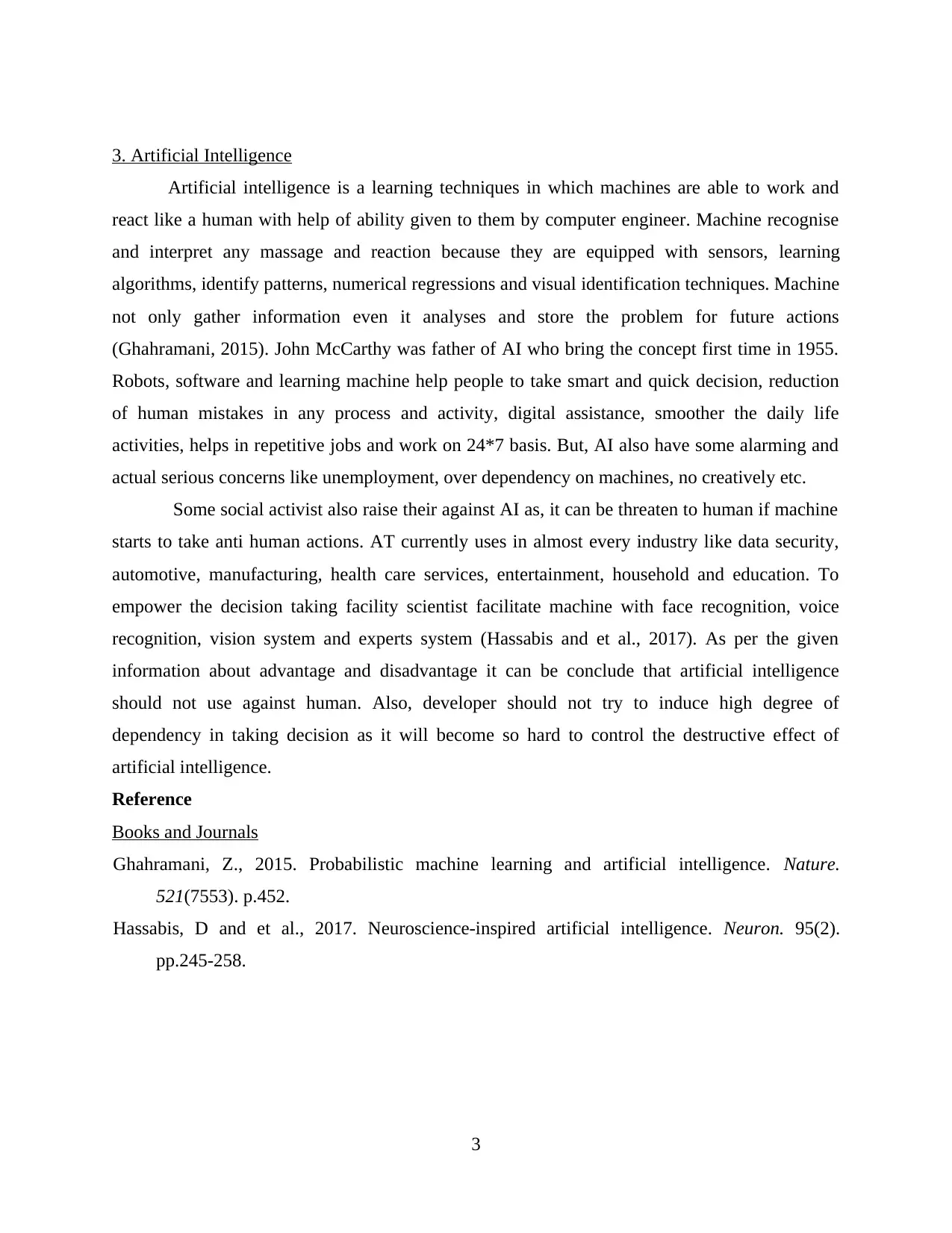
3. Artificial Intelligence
Artificial intelligence is a learning techniques in which machines are able to work and
react like a human with help of ability given to them by computer engineer. Machine recognise
and interpret any massage and reaction because they are equipped with sensors, learning
algorithms, identify patterns, numerical regressions and visual identification techniques. Machine
not only gather information even it analyses and store the problem for future actions
(Ghahramani, 2015). John McCarthy was father of AI who bring the concept first time in 1955.
Robots, software and learning machine help people to take smart and quick decision, reduction
of human mistakes in any process and activity, digital assistance, smoother the daily life
activities, helps in repetitive jobs and work on 24*7 basis. But, AI also have some alarming and
actual serious concerns like unemployment, over dependency on machines, no creatively etc.
Some social activist also raise their against AI as, it can be threaten to human if machine
starts to take anti human actions. AT currently uses in almost every industry like data security,
automotive, manufacturing, health care services, entertainment, household and education. To
empower the decision taking facility scientist facilitate machine with face recognition, voice
recognition, vision system and experts system (Hassabis and et al., 2017). As per the given
information about advantage and disadvantage it can be conclude that artificial intelligence
should not use against human. Also, developer should not try to induce high degree of
dependency in taking decision as it will become so hard to control the destructive effect of
artificial intelligence.
Reference
Books and Journals
Ghahramani, Z., 2015. Probabilistic machine learning and artificial intelligence. Nature.
521(7553). p.452.
Hassabis, D and et al., 2017. Neuroscience-inspired artificial intelligence. Neuron. 95(2).
pp.245-258.
3
Artificial intelligence is a learning techniques in which machines are able to work and
react like a human with help of ability given to them by computer engineer. Machine recognise
and interpret any massage and reaction because they are equipped with sensors, learning
algorithms, identify patterns, numerical regressions and visual identification techniques. Machine
not only gather information even it analyses and store the problem for future actions
(Ghahramani, 2015). John McCarthy was father of AI who bring the concept first time in 1955.
Robots, software and learning machine help people to take smart and quick decision, reduction
of human mistakes in any process and activity, digital assistance, smoother the daily life
activities, helps in repetitive jobs and work on 24*7 basis. But, AI also have some alarming and
actual serious concerns like unemployment, over dependency on machines, no creatively etc.
Some social activist also raise their against AI as, it can be threaten to human if machine
starts to take anti human actions. AT currently uses in almost every industry like data security,
automotive, manufacturing, health care services, entertainment, household and education. To
empower the decision taking facility scientist facilitate machine with face recognition, voice
recognition, vision system and experts system (Hassabis and et al., 2017). As per the given
information about advantage and disadvantage it can be conclude that artificial intelligence
should not use against human. Also, developer should not try to induce high degree of
dependency in taking decision as it will become so hard to control the destructive effect of
artificial intelligence.
Reference
Books and Journals
Ghahramani, Z., 2015. Probabilistic machine learning and artificial intelligence. Nature.
521(7553). p.452.
Hassabis, D and et al., 2017. Neuroscience-inspired artificial intelligence. Neuron. 95(2).
pp.245-258.
3
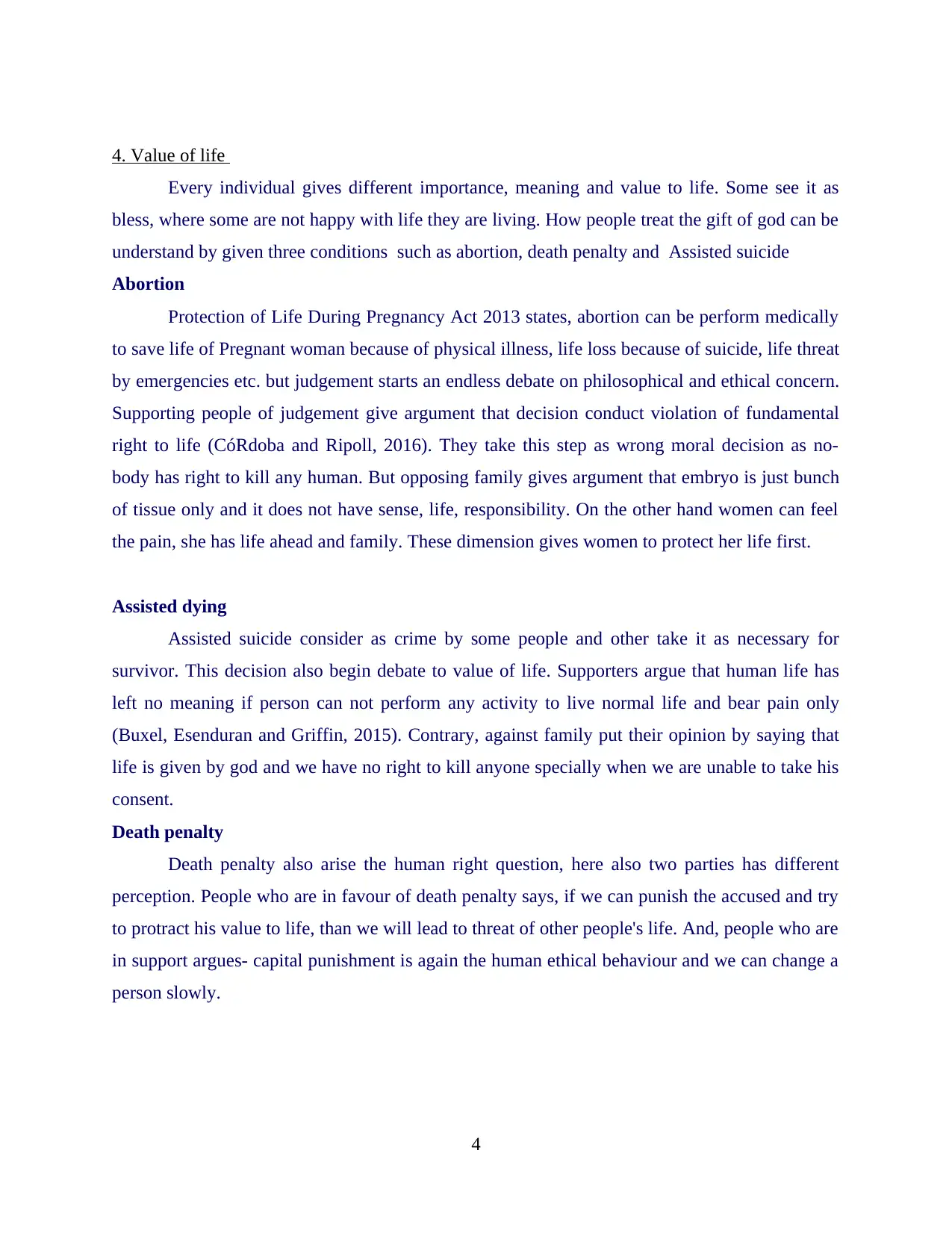
4. Value of life
Every individual gives different importance, meaning and value to life. Some see it as
bless, where some are not happy with life they are living. How people treat the gift of god can be
understand by given three conditions such as abortion, death penalty and Assisted suicide
Abortion
Protection of Life During Pregnancy Act 2013 states, abortion can be perform medically
to save life of Pregnant woman because of physical illness, life loss because of suicide, life threat
by emergencies etc. but judgement starts an endless debate on philosophical and ethical concern.
Supporting people of judgement give argument that decision conduct violation of fundamental
right to life (CóRdoba and Ripoll, 2016). They take this step as wrong moral decision as no-
body has right to kill any human. But opposing family gives argument that embryo is just bunch
of tissue only and it does not have sense, life, responsibility. On the other hand women can feel
the pain, she has life ahead and family. These dimension gives women to protect her life first.
Assisted dying
Assisted suicide consider as crime by some people and other take it as necessary for
survivor. This decision also begin debate to value of life. Supporters argue that human life has
left no meaning if person can not perform any activity to live normal life and bear pain only
(Buxel, Esenduran and Griffin, 2015). Contrary, against family put their opinion by saying that
life is given by god and we have no right to kill anyone specially when we are unable to take his
consent.
Death penalty
Death penalty also arise the human right question, here also two parties has different
perception. People who are in favour of death penalty says, if we can punish the accused and try
to protract his value to life, than we will lead to threat of other people's life. And, people who are
in support argues- capital punishment is again the human ethical behaviour and we can change a
person slowly.
4
Every individual gives different importance, meaning and value to life. Some see it as
bless, where some are not happy with life they are living. How people treat the gift of god can be
understand by given three conditions such as abortion, death penalty and Assisted suicide
Abortion
Protection of Life During Pregnancy Act 2013 states, abortion can be perform medically
to save life of Pregnant woman because of physical illness, life loss because of suicide, life threat
by emergencies etc. but judgement starts an endless debate on philosophical and ethical concern.
Supporting people of judgement give argument that decision conduct violation of fundamental
right to life (CóRdoba and Ripoll, 2016). They take this step as wrong moral decision as no-
body has right to kill any human. But opposing family gives argument that embryo is just bunch
of tissue only and it does not have sense, life, responsibility. On the other hand women can feel
the pain, she has life ahead and family. These dimension gives women to protect her life first.
Assisted dying
Assisted suicide consider as crime by some people and other take it as necessary for
survivor. This decision also begin debate to value of life. Supporters argue that human life has
left no meaning if person can not perform any activity to live normal life and bear pain only
(Buxel, Esenduran and Griffin, 2015). Contrary, against family put their opinion by saying that
life is given by god and we have no right to kill anyone specially when we are unable to take his
consent.
Death penalty
Death penalty also arise the human right question, here also two parties has different
perception. People who are in favour of death penalty says, if we can punish the accused and try
to protract his value to life, than we will lead to threat of other people's life. And, people who are
in support argues- capital punishment is again the human ethical behaviour and we can change a
person slowly.
4
⊘ This is a preview!⊘
Do you want full access?
Subscribe today to unlock all pages.

Trusted by 1+ million students worldwide
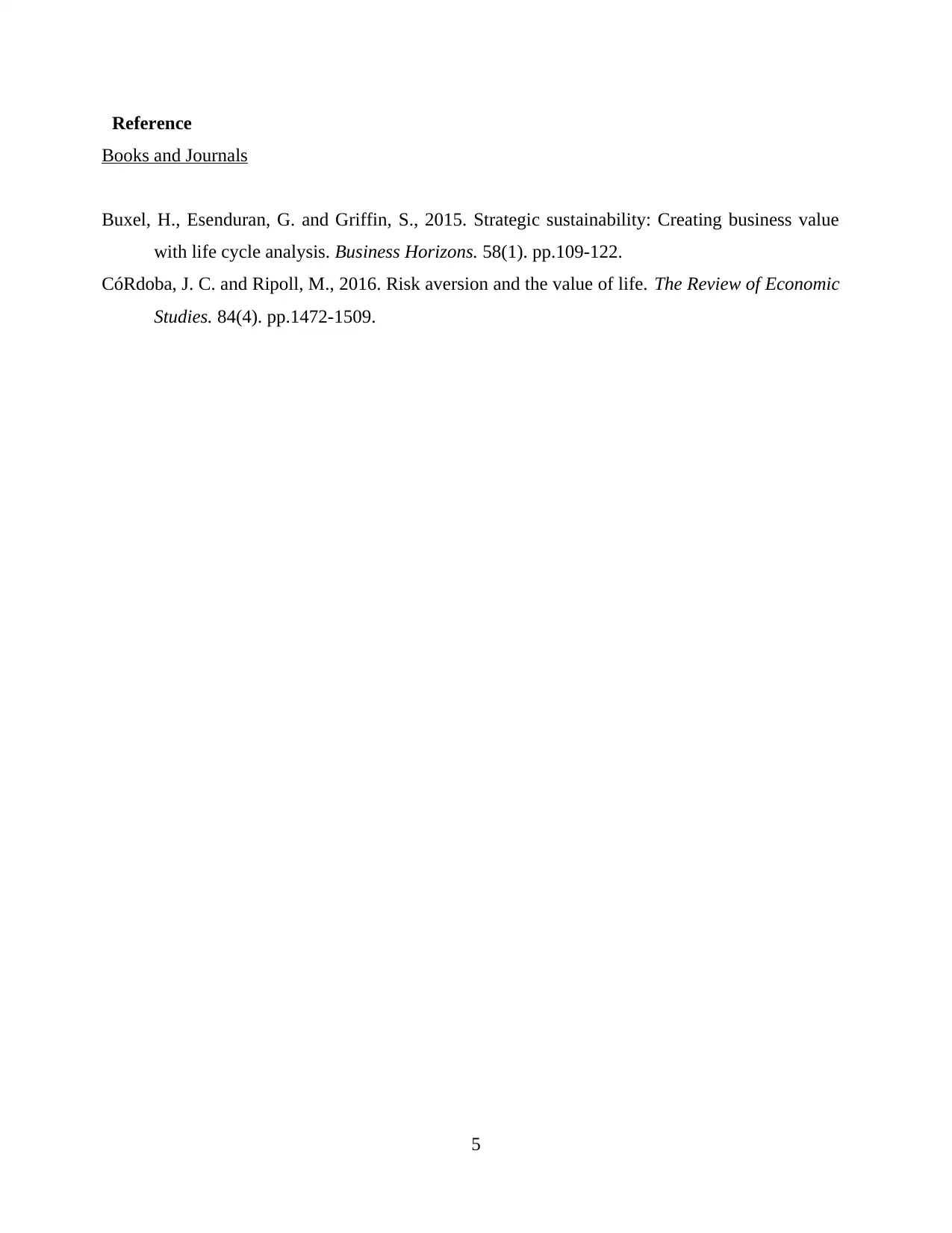
Reference
Books and Journals
Buxel, H., Esenduran, G. and Griffin, S., 2015. Strategic sustainability: Creating business value
with life cycle analysis. Business Horizons. 58(1). pp.109-122.
CóRdoba, J. C. and Ripoll, M., 2016. Risk aversion and the value of life. The Review of Economic
Studies. 84(4). pp.1472-1509.
5
Books and Journals
Buxel, H., Esenduran, G. and Griffin, S., 2015. Strategic sustainability: Creating business value
with life cycle analysis. Business Horizons. 58(1). pp.109-122.
CóRdoba, J. C. and Ripoll, M., 2016. Risk aversion and the value of life. The Review of Economic
Studies. 84(4). pp.1472-1509.
5
Paraphrase This Document
Need a fresh take? Get an instant paraphrase of this document with our AI Paraphraser

REFERENCES
Books and Journals
6
Books and Journals
6
1 out of 8
Related Documents
Your All-in-One AI-Powered Toolkit for Academic Success.
+13062052269
info@desklib.com
Available 24*7 on WhatsApp / Email
![[object Object]](/_next/static/media/star-bottom.7253800d.svg)
Unlock your academic potential
Copyright © 2020–2025 A2Z Services. All Rights Reserved. Developed and managed by ZUCOL.





